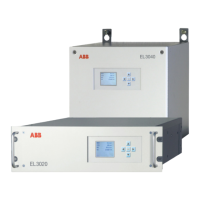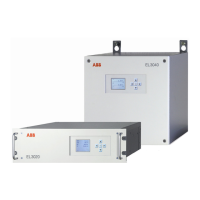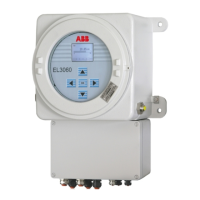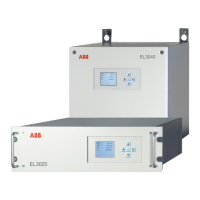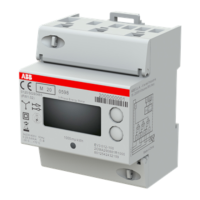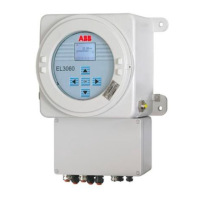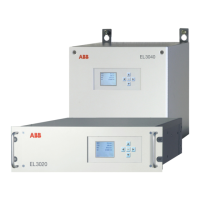8 EasyLine EL3000 Series Data Sheet 10/24-4.10 EN Rev. 9
Oxygen analyzer Magnos206
Measurement principle
Paramagnetic behavior of oxygen
Magnetomechanical oxygen analyzer; short 90% response time
Sample component and measurement ranges
Sample component
Oxygen (O
2
)
Smallest measurement range
0–2 vol.-% O
2
Measurement range quantity and limits
2 measurement ranges
Measurement ranges are freely adjustable; they are factory-
set per order to 0–5 or 0–100 or 98–100 vol.-% O
2
.
Largest measurement range
0–100 vol.-% O
2
Measurement ranges should not be set within ignition limits.
Measurement ranges with suppressed zero-point
Suppressed measurement ranges are freely adjustable in the
range 0–100 vol.-% O
2
. Smallest span 2 vol.-% O
2
. The
combination of a suppressed and an initial measurement
range is not possible.
Pressure correction with a pressure sensor is required.
A pressure sensor is installed when the analyzer has been
ordered with suppressed measurement range.
Stability
The following data apply only if all influence factors (e.g. flow
rate, temperature, atmospheric pressure) are constant. They are
based on a span of 2 vol.-% O
2
.
Linearity deviation
≤ 0.5 % of span
Repeatability
≤ 50 ppm O
2
(time base for gas exchange ≥ 5 minutes)
Zero drift
≤ 3 % of span of the smallest measurement range (per order)
per week, minimum 300 ppm O
2
per week; following pro-
longed transport and storage time the drift can be higher
during the first weeks of operation.
Sensitivity drift
≤ 0.1 vol.-% O
2
per week or ≤ 1 % of measured value per week
(not cumulative), whichever is smaller.
≤ 0.25 % of measured value per year, minimum 0.05 vol.-% O
2
per year
Output fluctuation (2 σ)
≤ 25 ppm O
2
at electronic T90 time (static / dynamic) = 3 /0 sec
Detection limit (4 σ)
≤ 50 ppm O
2
at electronic T90 time (static / dynamic) = 3 /0 sec
Influence effects
Flow effect
≤ 0.1 vol.-% O
2
in the 30–90 l/h range
Associated gas effect
The effect of associated gases as a shift of the zero-point
– expressed in vol.-% O
2
– can be estimated using the
approximate values in the following table:
Associated gas concentration
100 vol.-%
Zero-point shift in
vol.-% O
2
Hydrogen H
2
+0.28
Hydrogen sulfide H
2
S –0.45
Argon Ar –0.26
Helium He +0.30
Neon Ne +0.13
Nitrogen N
2
0.00
Nitrogen oxide NO +43.00
Nitrogen dioxide NO
2
+28.00
Nitrous oxide N
2
O –0.20
Carbon monoxide CO –0.01
Carbon dioxide CO
2
–0.32
Carbon oxysulfide COS –0.90
Ethane C
2
H
6
–0.46
Ethylene C
2
H
4
–0.29
Methane CH
4
–0.24
Propane C
3
H
8
–0.98
Propylene C
3
H
6
–0.55
Trichloroethane C
2
HCl
3
–2.17
Vinyl chloride CH
2
CHCl –0.75
For further associated gases refer to EN 61207-3
Temperature effect
Ambient temperature in the permissible range
– At zero-point: ≤ 1 % of span per 10 °C, ≤ 2 % of span per
10 °C in combination with Uras26
– On sensitivity: ≤ 0.2 % of measured value per 10 °C
Thermostat temperature = 64 °C
Air pressure effect
– At zero-point: No effect
– On sensitivity with no pressure correction:
≤ 1 % of measured value per 1 % air pressure change
– On sensitivity with pressure correction using integrated
pressure sensor (optional):
≤ 0.01 % of measured value per 1 % pressure change or
≤ 0.002 vol.-% O
2
per 1 % pressure change, whichever is
greater
Pressure sensor working range: p
abs
= 600–1250 hPa
Power supply effect
Voltage and frequency in the permissible range: ≤ 0.2 % of
span
Position effect
Zero-point shift ≤ 0.05 vol.-% O
2
per 1° deviation from
horizontal orientation. Position has no effect on the hard-
mounted unit.

